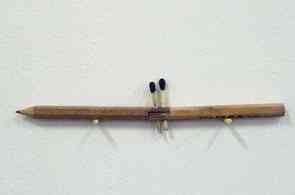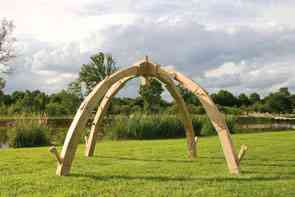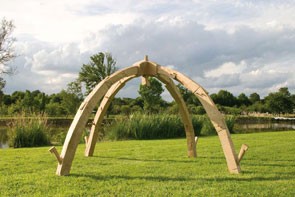Isabelle Frémin
Isabelle Frémin is an Astérides Resident in 2010. The archives of Triangle-Astérides do not allow for the determination of the exact dates or the duration of this residency in 2010.
“Life: A User’s Manual”
“…in the land of technology, immediate reality has turned into an unattainable romantic ideal.”
– Walter Benjamin
Isabelle Frémin fights against time. A technological, cybernetic time that deprives humans of a quantifiable and intelligible relationship with reality. Counting, traveling, communicating—these are all activities that no longer hold the same meaning in the era of high-tech calculators, high-speed trains, and Twitter. Indeed, all these new tools are permanently altering our perception of the everyday, introducing severe distortions. Isabelle Frémin is fully aware of these perverse mechanisms. More than just an artistic approach, she claims a broader attempt to understand the social, economic, and cultural stakes shaping our world. However, her works—imbued with humor and a certain naiveté—avoid any moralizing critique of our productivist and consumerist system.
Like a scout discovering the joys of voluntary simplicity, Isabelle Frémin delights in crafting objects to test a kind of hands-on know-how now rendered obsolete. The piece Système D’s not dead perfectly illustrates this approach of playful rivalry. Two pencils (courtesy of IKEA) are inserted one into the other and held in place by matches serving as pegs. Through its evocative title, the piece explicitly references the Swedish giant’s ingenuity in design. But by repurposing mass-produced objects into a kind of “assisted ready-made,” the artist also displays resourcefulness and positions herself as a competitor. Playful, even at times recreational, Isabelle Frémin’s works reveal both the keen intellect of their maker and her affection for simple, efficient forms.
Athletic Performance
In her sculptures and installations, Isabelle Frémin primarily uses wood—a noble and ecological material—engaging with it in a manner that blends athletic challenge with minimalist pursuit. Confronted with the constraints and rigidity of this medium, the artist constantly seeks to push its limits in search of the essential gesture. This is why, despite the conceptual nature of the finished work, there is often a performative dimension to Isabelle Frémin’s art. As if the object created serves as a springboard for a future action—even if purely hypothetical.
Serving as a literal and figurative pedestal for a Backstroke Start, the sculpture becomes elsewhere a pretext for a sound performance that culminates in The Nail of the show. In the former, the sculpture presents itself with immediate simplicity: a diving board made from a section of a tree trunk, equipped with a lateral bar allowing the swimmer to launch from the top of their platform. However, the true humor lies in the viewer’s effort to imagine the swimsuit-clad swimmer perched like a bird on their branch. In contrast, The Nail emerges only at the end of a 45-minute improvised performance involving a drill and planer, culminating in a ridiculously small sculpture: a nail.
Perfect Little Handyman Kit
It becomes clear that Isabelle Frémin transforms the world around her by diverting objects from their original function and playing on the meanings of words. With a fascination tinged with ambivalence for “packaging”—that marketing science aimed at increasing consumer desire through ever more appealing wrapping—the artist adopts its codes only to mock them. The “Three-Month Tent” is the very symbol of this masquerade. Unlike the instant “2 Seconds” tent sold by Decathlon, Isabelle Frémin’s tent resembles vernacular architecture: raw and massive in appearance. Economical—since all its components come from a single tree trunk—the “Three-Month Tent” is, however, the antithesis of a disposable commercial product.
Though accompanied by instructions detailing each construction step—from squaring the trunk to assembling the pegs and frame—its setup requires carpentry tools and a good dose of patience. In her own way, the artist mocks the overuse of confusing instruction manuals, both in DIY and contemporary art. Taking the parody even further, Frémin presents a limited series of eight unique kits, each containing a video of the artist at work during the three months it took to build the tent.
From this perspective, Isabelle Frémin aligns with artists whose work embraces “useless” practices, such as Jean-Baptiste Farkas with his IKHEA ©services project, which offers, in addition to a DIY guide for home renovators, in-home assistance. Similarly, Israeli artist Guy Ben-Ner’s Treehouse Kit, which transforms a tree into living room furniture, questions in ironic fashion our consumption habits and our relationship to nature in the age of technical reproducibility. It is this opposition—less binary than it seems—between artisanal making and a lukewarm fascination with industrial objects that defines one of the key issues at play in Isabelle Frémin’s work.
Time-Out
Another strategy employed by the artist is making the viewer aware of time’s passage. In English, a “time-out” refers to a pause in play called by one of the opposing teams. The word “out” thus marks a spatial and temporal boundary beyond which any action is null and void. Similarly, in her sculptural and video practice, Isabelle Frémin creates kinds of freeze-frames—critical and humorous reflections on how we consume time in Western societies.
The most emblematic work of this suspended state is the Manual Date Clock, shown in the Perspective cavalière exhibition at the Palais de Tokyo in February 2010. It features a dial and numerous wooden components. The concept is simple, as the instructions state: “Every minute, change the time, and once a day, the date.” Instead of helplessly watching the seconds tick by, one becomes the actor—if not the slave—of their own time. As the artist promises: “You’ll have the satisfaction of being your own timekeeping device.”
The 23rd Minute is a video in which the artist is seen sculpting the number 23 into a block of wood while a handmade timecode scrolls across the top of the screen. To make this video, Frémin first carved each number into wooden pieces (60 in total), then photographed them individually to create a sequence of images. She then animated them in quick succession, mimicking the display of a digital timer.
One might question the point of such a long and tedious process when devices exist to do the same job at a fraction of the cost. Yet it is precisely in this fictional, absurd competition with machines that the work finds its meaning. In trying to reproduce a mechanical object by hand, the sculptor reclaims the inventiveness inherent to industrial creation. In this way, the apparent failure of the artist transforms into an act of restoring dignity to the manufactured object—and, by extension, to its creator.
In a nearly philosophical mode, Isabelle Frémin underscores the futility of her endeavor by drawing attention to both the act and its result. Watching the artist at work allows us to grasp the full extent of the effort and persistence required. Unlike Chaplin’s character in Modern Times, who suffers from assembly-line alienation, the artist imposes upon herself a systematic production as a personal challenge to test the physical and psychological limits of her art. And as if this battle against time weren’t enough, the artist-demiurge seems intent on rivaling Mother Nature herself. Rumor has it she secretly dreams of inventing a machine to make the wind…
Text by Septembre Tiberghien, April, 2011
Translation: Triangle-Astérides
The portrait of Isabelle Frémin was created as part of an invitation to Portraits, la galerie.



